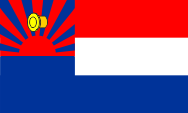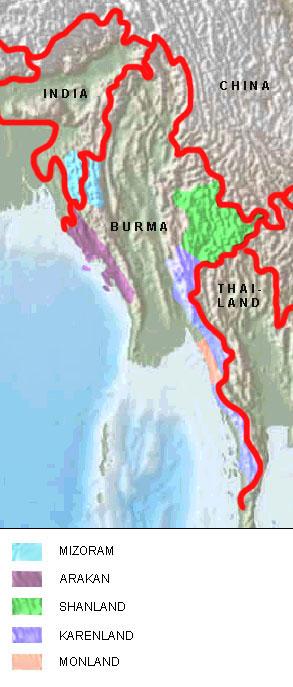mobile View, to the German Version tap the flag


- Kayin Land, Karen State
- 1947–1948 independent
- 1948 half-autonomous state in Burma with strong secessionistic tendencies
- 1951–1973 named "Kawthoolei"
• Flag
• Meaning/Origin of the Flag
• Map
• Numbers and Facts
• History

Flag of the Kayin State,
ratio = 1:2,
Source, by: Flags of the World




Flag of Kawthoolei (KNU Party),
Source, by: burmalink.org, Die Welt der Flaggen




The flag of Kayin State, as a province of Burma (Myanmar) shows the colours blue, white and red in horizontal stripes and in the upper corner a white Star. The latter certainly stands for Burma. The flag of Kawthoolei, the independent state of the Karen-Nation, for which the Karen National Union has fought since 1948, shows the colours red, white and blue in horizontal stripes and in the upper corner a stylized rising sun and a golden drum. About the origin and the meaning of the flag is here nothing known. There could be made the following speculation: The establishment of the independent Kayin State coincides with the anti-Japanese resistance and the end of the Second World War, so that the Karen could had elected the color's sequence of blue-white-red already during the war, to express their affiliation to the allies by using their colours. A similar process was once already performed in the year 1917 in the neighbouring country Thailand.
Source: Volker Preuß


Source: Freeware, University of Texas Libraries,
modyfied by: Volker Preuß

Area: 11.731 square miles
Inhabitants: 1.574.000 (2014)
Religions: 85% Buddhist, 9% Christian, 4% Muslim
Density of Population: 134 inh./sq.mi.
Capital: Hpaan (Hpa-an, Pa-an), 421.500 inh. (2014)
official Languages: Burmese, Kayin (Karen)
other Languages: Padaung, Bamar ...
Currency: Burmese currency
Time Zone: GMT + 6,5 h
Source:
Wikipedia (EN)

The Karen (KaRyang, Kayin), a sino-tibetian people, opposed already in the times of the British colonization the power's ambitions of the Burmese, even with British support. After the subjection by United Kingdom (1886) the Karen were used by the British within their colonial army preferably against the Burmese "liberation army". During the Japanese occupation in the 2nd World War fought the Karen under the guidance of British military officers against the Japanese. After the withdrawal of the Japanese the Karen saw their chance and declared themselves for independent in the year 1947. In the struggles with Burmese militias, in which the Karen were supported by the British, they could contend until 1948. The Burmese annexed the Karen State in 1948 as a semi autonomous state to their State of Birma, which became independent from United Kingdom in the same year. Between 1951 and 1973 Kayin State carryed the name Kawthoolei. The Karen continued the struggle for a from Burma independent state, and had to accept in 1950 heavy military setbacks and signed in 1964 an agreement with the Burmese to stop the fightings. Partisans of the Karen however continued their fight in the mountains region, especially near the frontier to Thailand, and against the in 1962 established "Right and Law Reconstruction Council" (SLORC), a Burmese instrument of terror. In the year 1976 the SLORC determined a program for resettlement. The Karen people in the country had to go so quick as they could to the stated resettlement locations, where they stayed without enough food and medical support. In 1988 followed protest rallies against the 26 years of the SLORC military rule. Thousands of protesting Karen get murdered, and the Karen reserves came under direct military control. Until the middle of the nineties the partisans of the Karen could achieve substantial territorial gains. A further advance of the Karen was stopped by an attack of the governmental troops. In 1995 the "Karen National Partei" and the SLORC came to an agreement about an armistice, which schould finish the since 48 years enduring war. This armistice had not a long live. The brutality and systematical injuries against the human rights by the SLORC are all well proven and documented. The Karen are and remain economical and physical oppressed. In the Amnesty - International - Report from 1997 the Karen (in addition to the Shan and Mon) are represented as the mostly haunted people of Birma. It is estimated that only during the forced resettlements of the year 1996, 20.000 to 30.000 Karen lost all, houses, land and meagre personal possessions. The bigest part of them end in resettlement camps of the state, while 7.000 escaped to Thailand.
Source:
UNPO


![]()




